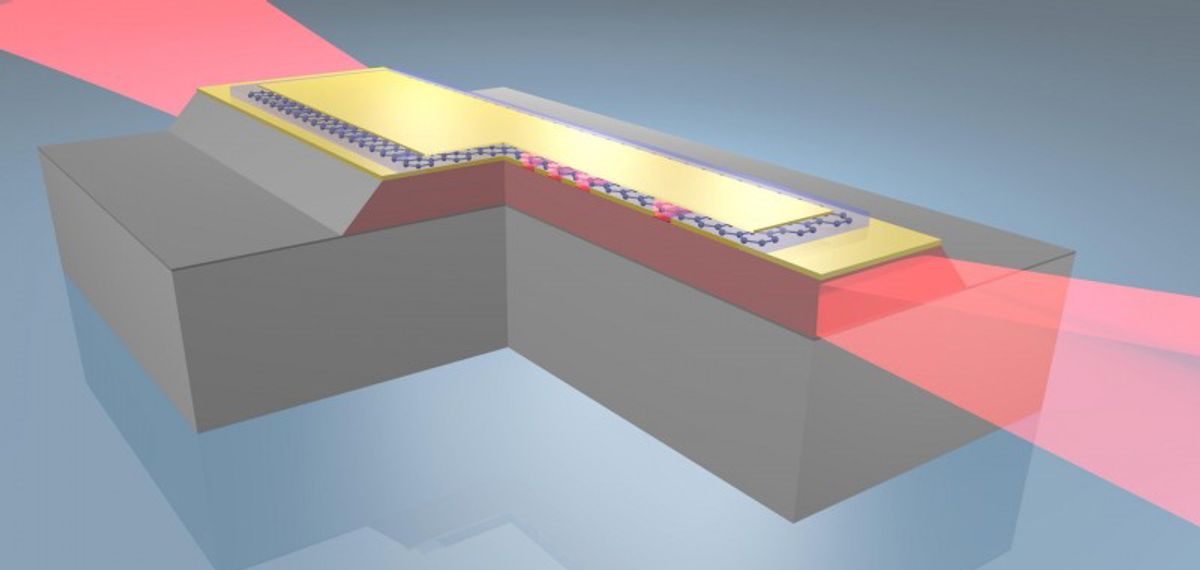Despite the myriad uses we have for lasers, once the wavelengths of light have been set for a laser, it’s usually fixed for that device.
Now researchers at the University of Manchester in the UK have demonstrated that they can tune a terahertz laser so that there is reversible control over its emission. They’ve done so by combining a graphene sheet with a terahertz quantum cascade laser. The key to this control over the laser’s emission is manipulating the doping of the graphene layer to change the concentration of charge carriers.
In research explained in a paper published in the journal Science, the Manchester researchers manipulated the doping levels of the graphene layer so that it generated plasmons on the surface of the graphene. Plasmons are the waves of electrons that are formed when photons hit a metal. A few years back, researchers discovered that graphene can generate plasmons on its surface just as well as metals can and that these graphene plasmons have some unique properties that don’t exist with typical metals, such as the fact that graphene plasmons can be tuned.
In fact, about five years ago, Konstantin Novoselov (who was an author of this latest research) and Andre Geim, the two University of Manchester scientists who won the Nobel Prize for discovering graphene, succeeded in improving photodetectors to the degree that they could boost optoelectronic data transfer rates by a factor of 20 by combing graphene with plasmonic nanostructures.
What Novoselov and his colleague and co-author, Subhasish Chakraborty, discovered in this latest research is that when this ability of graphene plasmons to be tuned is combined with terahertz quantum cascade lasers, it becomes possible to reversibly alter their emission. Essentially, the researchers replaced metal with graphene in the laser.
To make this switch, the Manchester researchers placed a series of quantum aluminum gallium arsenide and gallium arsenide wells of varied thickness onto a substrate in four prototype devices. These were then covered with a waveguide made of gold in which slits were cut to force electrons to travel between the wells. It’s here that the graphene was brought in and used to cover the gold. The entire device was then covered with a polymer electrolyte and a cantilever was used as a way for tuning their laser.
What the Manchester researchers have demonstrated here is control of terahertz lasers, which operate in the portion of the spectrum between microwave and infrared frequencies. Terahertz beams can be used to scan objects in a way similar to how X-rays are used but without causing any radiation damage.
For that reason, terahertz lasers have long been considered for applications such as airport scanners for detecting concealed weapons. Unfortunately, terahertz laser–based machines capable of these jobs are very complex instruments and fabrication has been difficult at best. Terahertz lasers have also been limited in these applications by the fact that they can only produce a fixed wavelength.
“Terahertz technologies have been somewhat ignored by industry, partly due to the complexity of creating high-power tunable devices, as lots of different materials were necessary,” said Chakraborty, in a press release. “Graphene can now fill in the gaps of this technology by creating a platform to electronically control devices and flexibly engineer device output.”
Novoselov added: “Current terahertz devices do not allow for tunable properties, a new device would have to be made each time requirements changed, making them unattractive on an industrial scale. Graphene however, can allow for terahertz devices to be switched on and off, as well as altering their state.”
Not only does this new approach to terahertz lasers make them a practical alternative for applications in which X-rays have been the de-facto technology, the tunable properties that graphene affords could find use in fiber optics telecommunication technologies by offering potentially higher bandwidth capabilities.
Dexter Johnson is a contributing editor at IEEE Spectrum, with a focus on nanotechnology.



